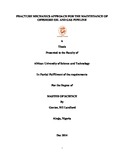| dc.contributor.author | Gontor, Bill Landlord | |
| dc.date.accessioned | 2016-06-14T09:54:46Z | |
| dc.date.available | 2016-06-14T09:54:46Z | |
| dc.date.issued | 2014-12-15 | |
| dc.identifier.uri | http://repository.aust.edu.ng/xmlui/handle/123456789/431 | |
| dc.identifier.uri | http://library.aust.edu.ng:8080/xmlui/handle/123456789/431 | |
| dc.description.abstract | Failure of offshore oil and gas pipelines occurs under certain conditions due to some applied mechanical forces. These conditions constitute a potential
threat to the integrity of in-service life span of the pipelines which can lead to loss of resources and environmental pollution. Several studies have shown that pipelines fail as a result of Welding, Fatigue Crack Growth, Corrosion Fatigue, Stress Corrosion Cracking, and Erosion due to fluid flow. This paper presents a model by using fracture mechanics to analyze the allowable applied stresses an in service pipeline needs to withstand in minimizing crack growth. Furthermore, the crack size, crack shape and hole radius with pipe thickness will be modeled. The modeling results will be validated using experimental data. The implications of the results will be discussed for the design or development of a robust oil and gas pipelines. | en_US |
| dc.language.iso | en | en_US |
| dc.subject | Gontor Bill Landlord | en_US |
| dc.subject | Prof Wole Soboyejo | en_US |
| dc.subject | 2014 Materials Science and Engineering | en_US |
| dc.subject | Fracture | en_US |
| dc.subject | Mechanics | en_US |
| dc.subject | Offshore Oil and Gas Pipeline | en_US |
| dc.subject | Gas | en_US |
| dc.subject | Oil | en_US |
| dc.title | Fracture Mechanics Approach for the Maintenance of Offshore Oil and Gas Pipeline | en_US |
| dc.type | Thesis | en_US |

